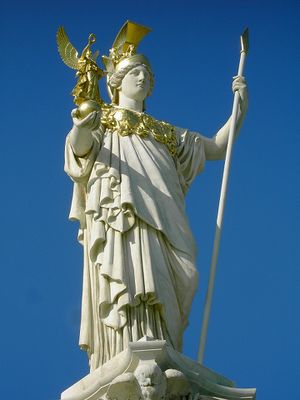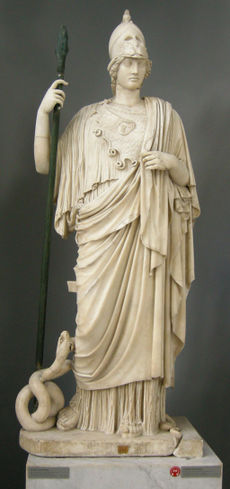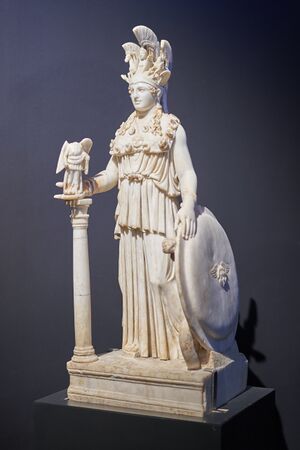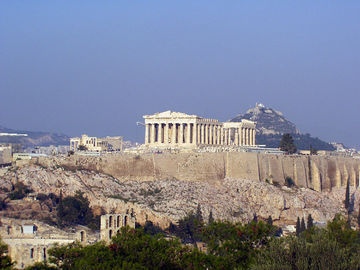Pallas Athena

Pallas Athena, the Goddess of Truth, is a tremendous being of light who ensouls the cosmic consciousness of Truth.
The flame of truth is an intense bright emerald green. It combines the flaming blue power of God’s will and the brilliant golden illumination of the intelligence of God. Her presence in the universe is the exaltation of the flame of living Truth. This truth she holds on behalf of the evolutions of earth as a member of the Karmic Board, where she serves as the representative on the fifth ray of truth, healing, supply and precipitation.
The one who holds the office of the Goddess of Truth has always given great assistance to the messengers of the Great White Brotherhood. Her scepter of power is the flaming sword of Truth that cleaves asunder the Real from the unreal and keeps the way of the Tree of Life in the Garden of Eden.
Embodiments
Pallas Athena was embodied as the high priestess in the Temple of Truth on Atlantis, serving under Vesta.
She later kept the Mother flame of truth in ancient Greece, as that temple and that temple flame were transferred from Atlantis to that land. She served as directress of the temple virgins and oracles at Delphi, who were messengers of the gods and goddesses who spoke Truth and the wisdom of the Law to the ancients. Pallas Athena and the members of the Brotherhood sought to keep alive the inner mysteries of the retreats. The memories of the gods, the functions of the temple virgins and the oracles of Delphi were the last vestiges of communication from the ascended masters in the Greek culture. After the closing over of those sources due to the discord and rebellion of the people, we begin to trace modern thought reaching and culminating in what manifests today as humanism.

In ancient Greece
Pallas Athena is the twin flame of the Maha Chohan, the representative of the Holy Spirit to the earth. Together they are an indomitable pair in defense of truth. The Maha Chohan was embodied as the Greek poet Homer, who spoke of Pallas Athena in his epic poems, the Iliad and the Odyssey.
Pallas Athena is one of the most important deities in Greek mythology, and in Roman mythology she is identified as Minerva. Her influence spans everything from the administration of government and militaristic pursuits to the delicate arts of spinning and weaving. She is seen as the very personification of wisdom who presides over the intellectual and moral side of human life.
Athena was the heart of the spiritual life of ancient Athens. The Greeks adored her as the defender of their cities and honored her with many titles. She is revered as the Goddess of War and Peace, the Goddess of Wisdom, patron of arts and crafts, and guardian of cities. She is also honored as the inventor and protector of culture and as the protector of civilized life and agriculture. She has been called the Counselor-Goddess and Goddess of the Assembly for her role in maintaining law and order in the courts and administering justice. She is also looked to as the Goddess of the Working Woman because of her mastery in spinning, weaving and needlework.
Among the many inventions attributed to her are the plow, the rake, the flute, the ship and the science of numbers. Her emblem is the olive, emblem of peace; and her bird is the owl, representative of wisdom.
Athena is popularly admired as the “martial maiden” who inspires and accompanies heroes in their adventures and battles, yet never succumbs to amorous advances, fiercely defending her virginity. She was one of three virgin-goddesses who could not be stirred by the influences of Aphrodite, the Goddess of Love. One of the earliest accounts of Athena appears in the Iliad, where she is a war goddess, inspiring and fighting alongside the Greek heroes. To possess her favor is considered synonymous with military prowess.
The Roman Emperor Julian said of her: “Unto men Athena gives good things—namely wisdom, understanding, and the creative arts. And she dwells in their citadels as being the founder of civil government through the communication of her own wisdom.”[1]
According to the traditions of Greek mythology, Pallas Athena was the favorite daughter of Zeus, the powerful father of the Gods and king of Mount Olympus. Her mother was the Goddess Metis, whose name means “thought” or “intelligence.” Metis was believed to be so wise that she knew more than all the gods and men together.

Zeus was warned that if he had children with Metis they would be more powerful than he and would eventually dethrone him. Thus, when Metis became pregnant with Athena, Zeus swallowed Metis in order to prevent the child’s birth. Soon after, Zeus became afflicted with a violent headache. He went to the smithy god Hephaestus, who split his skull with a bronze ax in order to relieve the pain. Out sprang the bright-eyed Athena in full armour, shouting triumphantly and brandishing a sharp spear!
The birth of Athena from the head of Zeus can be seen as symbolic of her rational temperament. Her very nature reflects the triumph of reason over passion, as she is consistently unmoved by the emotions of passion or romantic love. Her father is the most powerful and her mother the wisest of the gods and goddesses. Athena is thus a product of the union of power and wisdom.
The New Century Classical Handbook gives the following profile of Pallas Athena:
She personifies the clear upper air as well as mental clearness and acuteness, embodying the spirit of truth and divine wisdom. She participates with skill and wisdom in wars to defend the state, but does not fight, like the God of War, with uncontrolled ferocity for sheer love of strife. Her activities in war restore order, and thus she is a goddess of peace. She upholds law and order, encourages the arts by which the state is strengthened, and has invented so many aids to mankind that she is called the Contriver. She is the protectress of the young, the patroness of agriculture, of construction of all kinds, of healing and of music. She is especially devoted to the interests of mankind, for, some say, when Prometheus fashioned men of clay and water it was Athena who breathed life into them.[2]
Athena was worshiped all over Greece but especially as the protecting deity of Athens and Attica. As legend has it, both Poseidon and Athena desired to rule Athens. The gods decided that the one who produced a gift most useful to mortals would win the city. According to some versions, Poseidon struck the ground with his trident and produced a horse. According to other accounts, he produced a fountain of salt water. But it was Athena’s gift that won the favor of the gods: She planted an olive tree. The gods decided that her gift was more useful to mortals and awarded her the city. The olive tree later became the basis of the city’s economy.

To the Athenians, she was known as Parthenos, which means “Virgin,” or “Maiden.” They built the Parthenon in her honor on the Acropolis at Athens. The beautiful Parthenon was one of the largest Greek temples and a masterpiece of Greek architecture. It was the spiritual center of Athens. Built on a high hill, it was visible for miles around and stood as a symbol of Athenian culture, wealth and power. Inside, toward the west end, towered a forty-foot-high ivory and gold statue of the goddess, sculpted by Phidias.
Author David Kinsley writes:
A consistent theme in the mythology and cult of Athena is her identification with the city of Athens. The city is an extension of her, as it were—something that spreads and grows from the sacred center, the Acropolis, which is not only the dwelling of the goddess but the goddess herself.... Athena personifies or embodies the spirit of Athens as the expression of ideal civilized human existence.[3]
In art, Athena is represented as a stately figure, clothed in armour and bearing her breastplate, the aegis, which no arrow could pierce. The aegis is ringed in serpents and is adorned with the head of the Gorgon Medusa. Athena often wears a golden helmet and holds in her right hand a spear to strike at a serpent near her feet. It has thus been said that she wields the spear of knowledge against the serpent of ignorance. To the ancient Greeks, Athena was known as the Spear-shaker. They placed her statue on their temples, and when the rays of the sun would dance on her spear, it looked as if she were shaking it.
Pallas Athena was the muse and inspiration of Sir Francis Bacon, author of the Shakespearean plays, an embodiment of Saint Germain. In her honor, he founded a secret literary society called the Knights of the Helmet. It is believed that he used the name Shakespeare partly in tribute to the goddess Pallas Athena, the “shaker of the spear.”
The Coming Revolution in Higher Consciousness
On June 30, 1976, in Washington, D.C., Pallas Athena called for the raising of the consciousness of the people of earth by the flame of truth—the Coming Revolution in Higher Consciousness. She said:
I wish you would understand this day that when I say I AM Truth incarnate, I must rely upon your body, your flesh and your blood, your mind and your soul to be the incarnation of the Word of Truth that I AM!...
I AM Pallas Athena. I AM Greek. I AM Roman. I AM freeborn. I AM a member of every nation. I AM an American. From this day and forevermore, I claim you for the cause of Truth because you have made that cause your own. In the living flame of Truth, I am grateful for your love of Truth, of liberty, for your courage and your self-sacrifice. I am grateful, and I bow before the flame of Truth within you. And I will use that flame to light a nation and to light a world![4]
As a result of this dictation, Pallas Athena, Saint Germain and El Morya sent the messenger and their chelas throughout the world to bring the truth of the message of the ascended masters.
Retreat
► Main article: Temple of Truth
Pallas Athena ministers to mankind from the Temple of Truth above the Island of Crete. Serving directly under Vesta, the Sun Goddess, she focuses the truth of God’s love to the earth. She also works with Hilarion, the chohan of the fifth ray, and other healing and green-ray masters.
Souls come to the Temple of Truth in their finer bodies at night (during sleep) to be instructed in the fine points of cosmic law, the science of healing, mathematics, music, divine geometry and the laws of alchemy and precipitation. Many who come to society today with ingenious ways of opening the doors of higher understanding in these fields have studied under the masters in this retreat.
Whenever you are engaged in a service to the ascended masters, call to Pallas Athena and her legions of Truth to go before you, to be the bearer of the mighty sword of Truth for the binding of the force of anti-truth or Antichrist.
Sources
Mark L. Prophet and Elizabeth Clare Prophet, The Masters and Their Retreats, s.v. “Pallas Athena.”
Elizabeth Clare Prophet, June 30, 1993.
- ↑ G. A. Gaskell, Dictionary of All Scripture and Myth (N.Y.: Random House, 1981).
- ↑ Catherine Avery, ed., The New Century Classical Handbook (N.Y.: Appleton-Century-Crofts, 1962), p. 186.
- ↑ David Kinsley, The Goddesses’ Mirror: Visions of the Divine from East and West (Albany, N.Y.: State University of New York Press, 1989), p. 145.
- ↑ Pallas Athena, “America: Ye Shall Know the Truth and the Truth Shall Make You Free,” Pearls of Wisdom, vol. 44, no. 17, April 29, 2001.
